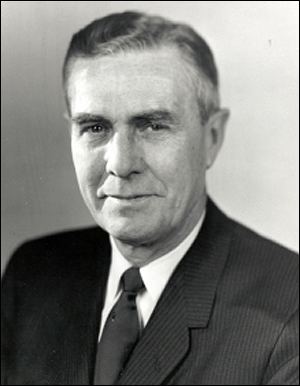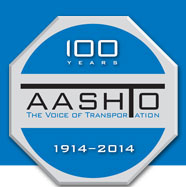
November 19, 2014
AASHTO Presidential Profile: Rex M. Whitton of Missouri

On December 9, 1955, the 41st AASHO Annual Meeting in New Orleans was adjourned by newly elected President Frank D. Merrill of New Hampshire. That promising start to a new AASHO presidency would end tragically only two days later when Merrill, who achieved international fame by that time as a leader of the legendary Merrill’s Marauders on behalf of the Allied forces in the China-Burma-India Theater during World War II, died of a heart attack.
As Merrill’s highways colleagues joined many others in mourning his death, the role of his successor as AASHO president fell to First Vice President Rex M. Whitton of Missouri. It was a daunting task for Whitton, not only because of the circumstances in which he assumed the association’s presidency but also because of the big challenges that he would face in the upcoming year. “However, these duties and responsibilities fall upon receptive shoulders, as Mr. Whitton has always been willing to accept additional responsibilities,” according to American Highways magazine.
Rex Marion Whitton was born on August 7, 1898, in Jackson County, Missouri. He graduated from the University of Missouri in 1920 with a bachelor’s degree in engineering. On May 1, 1920 -- only 11 days after graduation -- Whitton began what became his 40-year career with the Missouri State Highway Department. He started out serving as a member of a survey crew, specifically serving as a levelman on a 15-mile stretch of road in Johnson County, Missouri.
Whitton subsequently rose through the ranks of that agency to hold a variety of positions, including assistant project engineer; project engineer; chief of survey party; designer; assistant division engineer; division construction engineer; engineer of special assignments; assistant engineer of surveys and plans; and division engineer. In 1936, Whitton was named the agency’s engineer of maintenance. He developed what was regarded as one of the nation’s top maintenance organizations and in the process first established a national reputation for himself.
Through all those roles and responsibilities with the Missouri State Highway Department, Whitton became involved in and developed a deep knowledge of all phases of administration, economics, construction, operation and maintenance. He was ultimately appointed chief engineer of the agency on July 23, 1951, bringing to that role a wealth of experience and insights. “Naturally the acid test of any man is the caliber of the department that he administers or directs,” noted American Highways magazine. “One of the great highway departments of the country is that of Missouri. This alone is sufficient testimony to the ability of Rex M. Whitton.”
Whitton’s involvement in AASHO likewise had a long history. He attended his first AASHO annual meeting in 1922, when it was held in Kansas City and he helped make arrangements for that gathering. At the 1931 AASHO Annual Meeting in Salt Lake City, he took part in various highway design committee sessions. Whitton also went to the 1935 annual meeting in Miami, and then for more than two decades starting that year, would never miss attending any of those events.
As chief engineer, Whitton’s leadership in AASHO activities and programs included serving as chairman of the Operating Committee on Maintenance and Equipment. He was named a member of the AASHO Executive Committee in 1954 to replace R.A. Harris, who had just resigned as chief engineer of the Mississippi Highway Department. At the 1955 Annual Meeting, Whitton was selected First Vice President. Two days later, he automatically became president after Merrill’s untimely death.
Whitton’s tenure as president turned out to be among the most active and consequential in the history of the association. There was the enactment of far-reaching administrative changes, including an annual meeting policy that spelled out new requirements for headquarters hotels and the responsibilities of host states. That year also encompassed the start of construction of the facilities in Ottawa, Illinois, for the AASHO Road Test, which would be launched in 1958 and prove influential in overall highway design and construction nationwide.
The hugest priority and challenge for AASHO in 1956, however, involved helping to promote and secure authorization of the Interstate Highway System. The legislative proposals for the system had gone down into defeat during the previous year, and AASHTO and others supporting that highways network were determined this time around not to allow history to repeat itself. Consequently, Whitton -- along with other members of the AASHO Executive Committee – spent a considerable amount of time on Capitol Hill testifying on behalf of the Interstate Highway System and outlining the importance of legislation to make the program for those roads a reality.
Ultimately, Congress did pass the Federal Aid Highway Act of 1956 authorizing the Interstate Highway System and on June 29 President Dwight D. Eisenhower signed that measure into law. In the first few weeks after that enactment of the law, AASHO adopted geometric design standards for the new highways network and submitted those to the U.S. Bureau of Public Roads (BPR). That agency, acting on the behalf of the U.S. Chamber of Commerce, approved those standards. A new era for highways soon took shape across the nation.
During that same year, Missouri was the first state to award a contract based on funding under the landmark law – something that would become a point of pride for native son Whitton. That contract was for work on a segment of what is now Interstate 44 in Laclede County.
As he prepared to step down as president in November 1956 at the AASHTO Annual Meeting in Chicago, Whitton took time to salute his predecessor Merrill. Whitton also expressed appreciation for the enactment of the Federal Aid Highway Act of 1956, but also made a crucial point about what lay ahead in terms of building those new routes throughout the nation. “It is simply this – we have a job to do!” he said. “I know that we are going to do the job, but doing it will require courage, foresight, wisdom, initiative and vision.” Whitton was appointed Federal Highway Administrator of the BPR by President John F. Kennedy in 1961. Whitton’s achievements in that position included working to get the program for the Interstate Highway System on a more secure financial footing. Congress ended up passing the Federal Aid Highway Act of 1961 to accomplish that by increasing revenue for the Highway Trust Fund and guaranteeing that development of that roads network would continue on a pay-as-you-go basis. Kennedy signed the bill on June 29 of that year, which marked the fifth anniversary of when his predecessor Eisenhower had signed into law the 1956 act.
Whitton’s enthusiasm for the ongoing work of Interstate highways construction was very much in evidence not only through what happened in the Washington, D.C., but also in his numerous appearances at ribbon-cuttings and other dedication ceremonies for those routes. As a lighthearted acknowledgement of that busy schedule, AASHO Executive Secretary Alfred E. Johnson presented Whitton with gold-plated scissors at the 1964 annual meeting in Atlanta.
To enable BPR to better respond to emerging and ever-growing highway challenges, Whitton set up various new programs, including the Offices of Research Development; Planning; Right-of-Way & Location; Highway Safety; and Audits & Investigations. Whitton also became involved with highway issues on the world stage. He served as a U.S. delegate at many international conferences focused on highways, for example, and also visited many areas of the globe for consultation on a wide array of highway issues.
Whitton also proved himself to be a strong advocate for taking into consideration both the sociological and environmental impacts of highway planning and design, seeking feedback from ecologists, behavioral scientists, and civil rights specialists. President Lyndon B. Johnson, as a matter of fact, praised Whitton for making the nation’s highways “safer and more beautiful.”
Whitton served as administrator until Johnson accepted his letter of resignation on December 30, 1966. That brought to an end Whitton’s 46 years and eight months of public service. After retiring from BPR, Whitton served as a consultant for several years for the Kansas City office of the consulting engineering firm of Howard, Needles, Tammen and Bergendoff. He also used his spare time to supervise his three Missouri farms that totaled 281 acres.
Whitton also served as chairman of the Highway Research Board (now the Transportation Research Board). He received numerous awards during the course of his career, including the George S. Bartlett Award in 1958 for contributions to highway progress; the Thomas H. MacDonald Award in 1960 for outstanding service in highway engineering; and the Roy W. Crum Award in 1961 for distinguished service in highway research.
Whitton died in Kansas City on July 7, 1981 at the age of 82. Robert N. Hunter, who served as both chief engineer of the Missouri Department of Transportation and AASHTO president, paid tribute to Whitton at that time. “He had many remarkable abilities,” recalled Hunter. “His honesty and integrity were unquestionable, and he maintained the respect of all those he served.”












